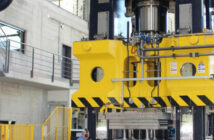Halogen-free flame retardants are used in many places. The purpose of flame retardants (or fire inhibitors) is to counteract the spread of fire. Flame retardants are used wherever there are potential sources of ignition. Electronic devices (risk of electrical short circuits) and upholstered furniture or carpets (risk of fire in rooms) are just two examples.
Halogen-free flame retardants from Gabriel-Chemie
Austrian Gabriel-Chemie offers a further development in halogen-free flame retardant masterbatches. Gabriel-Chemie with production sites Weitnau in Oberallgäu, Germany; Lázne Bohdanec in the Czech Republic; Paddock Wood in Great Britain; Nyíregyháza in Hungary and in Moscow, Russia has its head office in Gumpoldskirchen, Austria. In the field of additives, the products Gabriel offers include anti-fouling, anti-static, flame retardant, laser marking, and UV masterbatches.
Gabriel-Chemie has developed a set of halogen-free flame retardant masterbatches for a whole variety of applications and processing areas. Gabriel-Chemie presented its newly developed halogen-free flame retardant masterbatches at the „K“. Compared to earlier developments, these new masterbatches offer many innovative new features. The primary features Gabriel announced for its new products include easier processing and optimal mechanical properties. In addition, there are also more possibilities in the area of colour design. The use of other additives is equally as possible as a greater choice of polymers.
Halogen-free flame retardant masterbatch for thick-wall PP applications
In the area of thick-wall PP applications, Gabriel has developed the Maxithen PP7A9850FR halogen-free flame retardant masterbatch. This masterbatch eliminates one of the previous restrictions on the mechanical properties of halogen-free compounds. In any case, only halogen-free compounds are offered in the area of thick-wall PP applications. The reason for this are the classifications of the UL94 V-0, which make high demands on flame retardants of this kind.
Standards UL94 V-0, IEC/DIN EN 60695-11-10, CSA C 22.2
The flammability of plastic materials is the subject of the „Tests for Flammability of Plastic Materials for Parts in Devices and Applications“ of the Underwriters Laboratories (UL) regulation. This defines the procedure for assessing and classifying the flammability. European standards IEC/DIN EN 60695-11-10, IEC/DIN EN 60695-11-20 and Canadian CSA C 22.2 have adopted the provisions of UL94 V-0.
Areas of application in accordance with DIN 4102 B1, UL94 V-2
High flame retardancy requirements according to UL94 V-0 usually lead to restrictions in the mechanical properties, while the possibility of using even smaller amounts of flame retardant is sufficient for a variety of applications. These areas of application apply the provisions of DIN 4102 B1 and UL94 V-2. Precisely for this purpose as well as the environment of vertical flame retardant tests are the area of application of completely halogen-free flame retardant masterbatches such as the Maxithen PP7A9850FR from Gabriel. The spectrum of the recommended dosages ranges from 8% to 15%.
The lower concentrations of flame retardant offer a number of advantages. Easier processability and optimum mechanical properties are just two of the advantages. One can additionally expect more freedom in designing the colours. The use of other additives is equally as possible as well as a more generous selection of polymers.
Halogen-free flame retardant masterbatches for thin-wall PP applications
Typical thin-wall PP applications include fibres, tapes, and film made of polypropylene. Here again, a halogen-free flame retardant masterbatch from Gabriel-Chemie by the name of Maxithen PP7AA1940UVFR is also available. Flame retardant standards such as DIN 4102 B1 met by Gabriel-Chemie’s Maxithen PP7AA1940UVFR apply in the area of polypropylene thin-wall applications.
DIN 4102: fire behaviour in the building industry
DIN 4102 deals with fire behaviour in the building industry and classifies construction products into building material classes that describe the behaviour of substances and materials in fire. DIN 4102 B1 specifically deals with flame-resistant building materials such as DIN lightweight wood shaving wallboard and plasterboard in accordance with DIN 18180 and with perforated surfaces, rigid foam heat insulation boards with flame retardant additive, resin plaster on solid and mineral substrates made of mineral aggregates, floor coverings, oak parquet flooring, mastic asphalt, and rolled asphalt screed.
Can also be used for walls thicker than 150 microns
Gabriel-Chemie’s products pass the flame retardant tests for normally flammable thin-wall products according to DIN 4102 B2 and DNI-class FMVSS302 / DIN 75200 and VTM 2/0. And precisely this is new, since to date, halogen-free flame retardant masterbatches for thin-wall PP applications were available only with a limited temperature resistance. In addition, the previous master batches were suitable for use only for thin-wall PP applications up to a wall thickness of maximum 150 microns and were usually less effective.
Added benefits: UV stabilizer and improved LOI figures
Gabriel’s newly developed flameless flame retardant masterbatch Maxithen PP7AA1940UVFR for thin-wall polypropylene applications offers yet another additional benefit. Beyond acting merely a flame retardant, Maxithen PP7AA1940UVFR also acts as a UV stabilizer that protects against aging caused by UV radiation. Maxithen PP7AA1940UVFR additionally improves the LOI (limiting oxygen index), which is considered a minimum oxygen concentration determined by measuring and serves as a criterion for the flammability of textiles materials and plastics. The recommended added amounts and dosages for Maxithen PP7AA1940UVFR range between 7% and 15%.
Halogen-free flame retardant masterbatches for thin-wall PE applications
Maxithen HP7AA1460FR developed by Gabriel-Chemie as a halogen-free flame retardant masterbatch for thin-wall polyethylene (PE) applications complies with a host of flame retardant standards including those such as DIN 4102 B2, DIN 4102 B1, UL94 VTM-0 and UL94 VTM-2 for thin film, and FMVSS302/DIN75200. The polyethylene thin-film applications pertain to LDPE, LLDPE, as well as HDPE.
Maxithen HP7AA1460FR contains highly effective flame retardant additives, which do not reduce, for example, the transparency of the final product. Other halogen-free flame retardants have frequently failed with regard to wall thickness of 500 µm. It is exactly here where Maxithen HP7AA1460FR boasts its exceptional capabilities. The performance of Maxithen HP7AA1460FR remains outstanding even with a wall thickness of 500 µm.
The amounts to be added or the recommended dosage depends entirely on wall thickness and melt flow rate of the polymer. As a rule, a 3.5% to 8% dosage is recommended here to achieve flame retardant class DIN 4102 B2 while 9% to 13% is normally recommended for flame retardant class DIN 4102 B1. Higher LOI figures are obtained here as well.
Photo credits: © morguefile.com – wintersixfour (Bestuhlung), DodgertonSkillhause (Folie), Seemann (Vibre)










